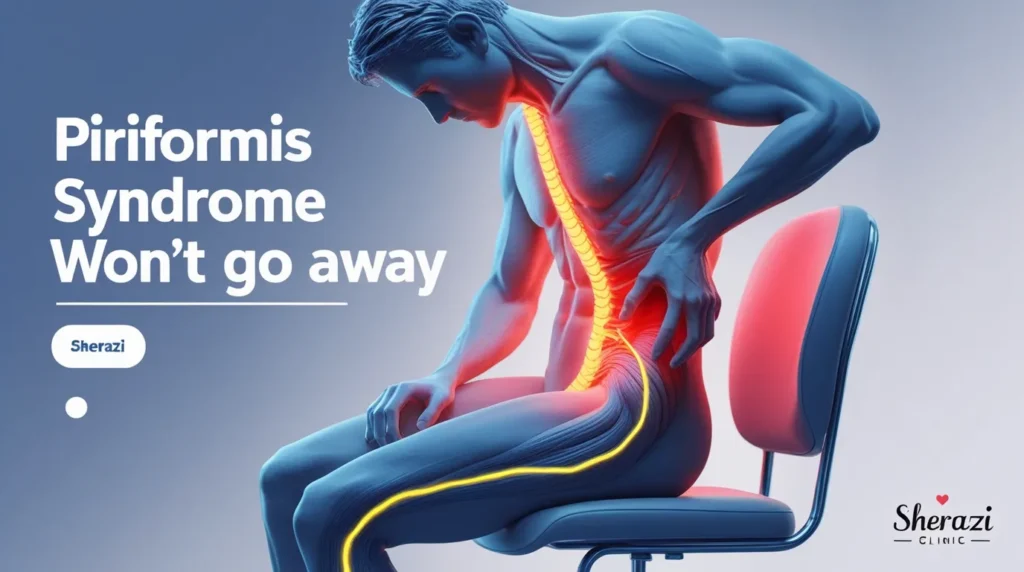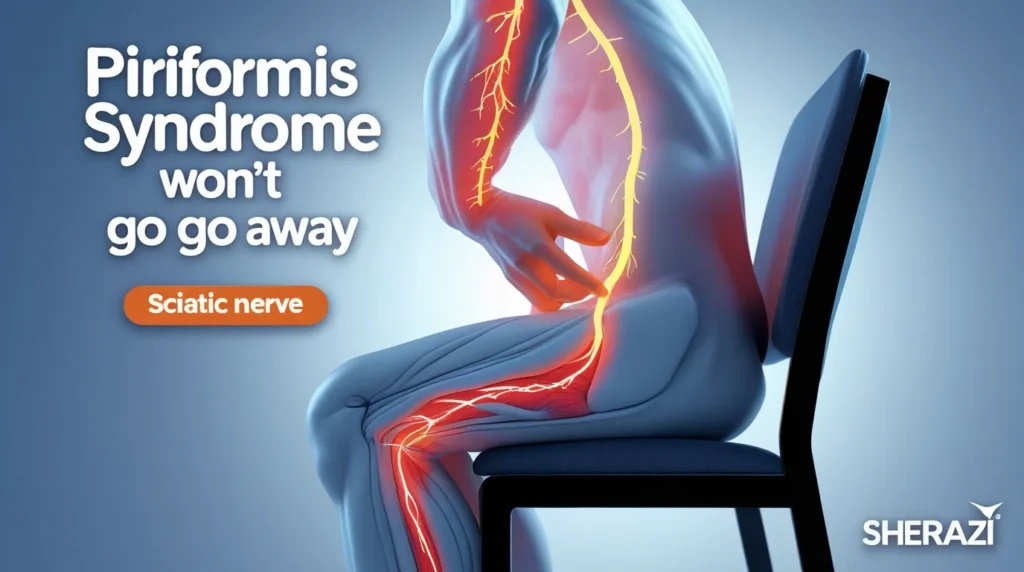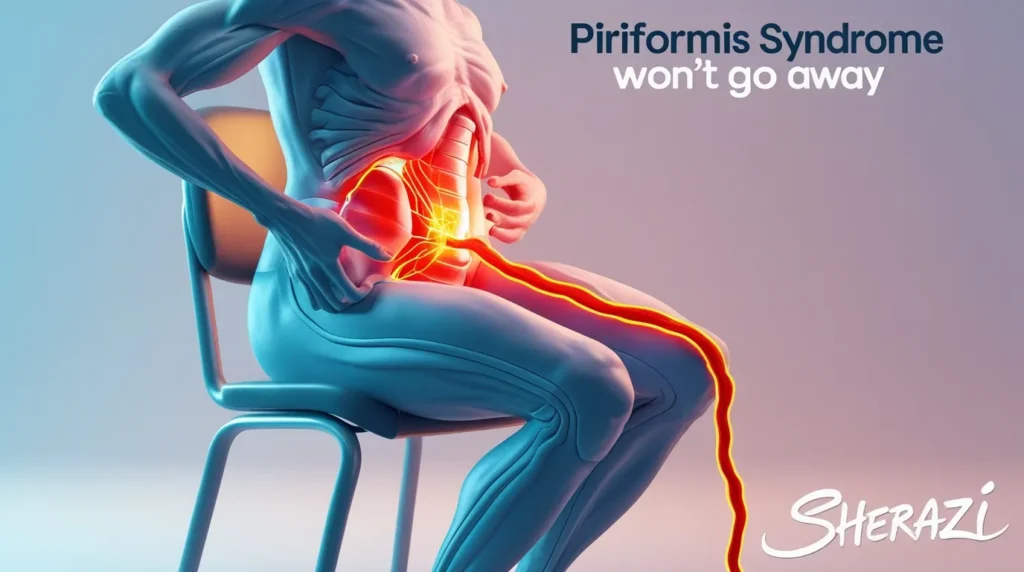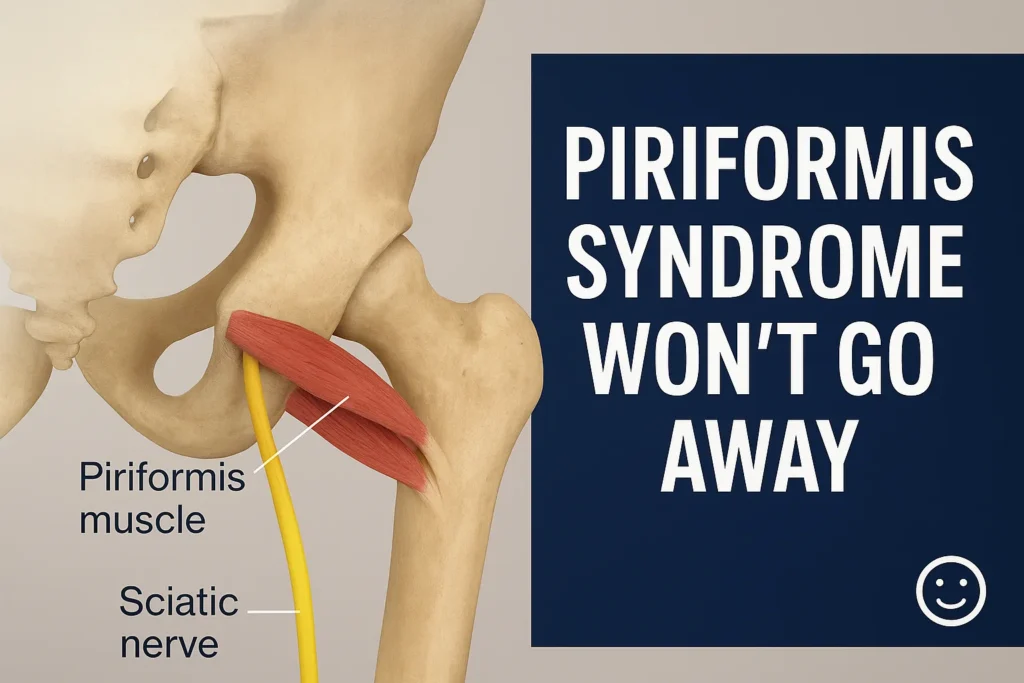Living with pain that refuses to fade can be frustrating and exhausting. If your piriformis syndrome won’t go away, you’re not alone. This condition often stems from a tight or inflamed piriformis muscle pressing on the sciatic nerve, leading to persistent buttock pain and sometimes tingling down the leg.
Many people struggle because they only treat the discomfort, not the root causes like muscle imbalance or poor hip mobility. Understanding why the pain persists is the first step toward real recovery. In this guide, we’ll explore proven strategies, from targeted stretches to strengthening routines, that can finally bring lasting relief for stubborn piriformis pain.
Understanding Piriformis Syndrome
The piriformis muscle sits deep in the buttock, close to the hip joint. Its main job is to rotate the leg outward and stabilize the hip. When it becomes tight, inflamed, or injured, it can press against the sciatic nerve, causing what many call pseudo-sciatica.
Unlike regular sciatica, which stems from the spine, piriformis-related pain starts in the buttock and often radiates down the back of the leg. For some, this pain feels sharp; for others, it’s a deep, dull ache that worsens with sitting or climbing stairs.
Common Signs and Symptoms
Recognizing the early signs of piriformis syndrome is key to preventing long-term issues. People often report buttock pain, hip stiffness, or a burning sensation that spreads down the leg.
Other common symptoms include numbness, tingling, and occasional lower back discomfort. These sensations often worsen after long periods of sitting, which keeps the piriformis muscle in a shortened, irritated state.
Why Piriformis Syndrome Won’t Go Away

If your piriformis syndrome won’t go away, there’s usually more to the story than just muscle tightness. Persistent pain often stems from a mix of factors such as weak glute muscles, poor posture, and even prolonged sitting during work or driving.
Another common reason is improper stretching. Over-stretching an inflamed muscle can actually increase irritation instead of easing it. Without addressing the root causes—like muscle imbalance or hip misalignment—the problem often lingers.
Diagnosing Persistent Piriformis Pain
A correct diagnosis helps avoid months of unnecessary discomfort. A healthcare professional will typically examine your posture, hip rotation, and gait. They may use the piriformis test, which checks for pain when the leg is rotated inward.
Sometimes, imaging like MRI or ultrasound is recommended to rule out a herniated disc or other conditions that mimic piriformis pain. This step ensures the pain isn’t coming from the spine or other deeper tissues.
Quick Relief Techniques for Piriformis Pain

While long-term recovery takes time, short-term relief is still important. Alternating ice and heat therapy can reduce swelling and ease muscle tension. Applying an ice pack for 15 minutes followed by a warm compress can often calm a flare-up.
Gentle self-massage using a foam roller or tennis ball against the buttock also helps by releasing tight spots. It’s best to start slowly, focusing on mild pressure to avoid further irritation.
Effective Piriformis Stretches and Muscle Release
Stretches are essential, but they need to be performed carefully. The figure-four stretch, done while seated or lying down, is one of the most effective for loosening a tight piriformis muscle.
Another helpful move is the standing step-back stretch, where you step one leg behind the other and gently lean back. Both stretches improve hip mobility and reduce tension, but they should be held for 20–30 seconds and repeated slowly to avoid over-straining the muscle.
Table: Popular Stretches and Their Benefits
| Stretch Name | Best For | How Often to Do |
|---|---|---|
| Seated Figure-Four | Loosens buttock and hip | 3–5 times daily |
| Standing Step-Back | Reduces piriformis tightness | 3–4 times daily |
| Lying Figure-Four | Improves hip flexibility | 3–5 times daily |
| Modified Pigeon Pose | Deep muscle release | 2–3 times daily |
Regular stretching is most effective when combined with strengthening exercises, which address the underlying muscle imbalance.
Strengthening Exercises for Long-Lasting Relief
Stretching alone isn’t enough. Weak glute muscles often force the piriformis to overwork, keeping it inflamed. Strengthening exercises like the wall slide, fire hydrant, and bird-dog improve hip stability and reduce stress on the piriformis.
For instance, the wall slide involves sliding your heel upward along a wall while lying on your side. It targets the piriformis and surrounding hip muscles. The fire hydrant, done on all fours, adds a gentle rotational movement that builds strength in the glutes. Over time, these moves improve balance and help prevent recurrent pain.
Preventing Future Piriformis Pain
The best way to keep pain from returning is to focus on daily habits. Sitting for hours on end compresses the piriformis muscle, so it’s helpful to take standing or walking breaks every 30–45 minutes.
Using an ergonomic chair that supports the lower back and hips can also make a difference. Including a brief stretching routine before and after exercise keeps the muscle flexible and less prone to strain.
When to See a Specialist

Most cases improve with home care, but some signs mean it’s time to get professional help. If your piriformis syndrome won’t go away after several weeks of stretching and strengthening, or if you notice severe nerve pain, leg weakness, or changes in bladder function, see a doctor immediately.
A specialist can recommend physical therapy, targeted injections, or other treatments that reduce inflammation and help restore normal movement.
Final Thoughts: Managing a Persistent Piriformis Syndrome

Dealing with a condition like piriformis syndrome that won’t go away can feel discouraging, but there’s hope. Combining consistent stretches, strengthening routines, posture correction, and medical guidance offers the best chance for long-term relief.
Remember, the key is not just to treat the pain but to fix the root causes. With patience and the right approach, it’s possible to move freely again and keep future flare-ups at bay.
✅ Quick Reference Table: Recovery Tips
| Approach | Why It Works | Consistency Needed |
|---|---|---|
| Ice/Heat Therapy | Reduces inflammation & muscle tension | Daily during flare-ups |
| Targeted Stretches | Improves hip mobility | 2–3 times per day |
| Strengthening Workouts | Balances glutes & hip muscles | 3–4 times per week |
| Posture Correction | Decreases pressure on the nerve | Ongoing |
| Professional Guidance | Custom solutions for stubborn pain | As recommended |
How to Sleep Fast in 2 Minutes Proven Methods for Instant Sleep
Unlocking the Secrets of Sleep The Key to Better Health and Happiness
Healthy Lifestyle Habits for a Better Life
FAQs
1. What is the fastest way to cure piriformis syndrome?
Targeted stretching, strengthening, and reducing activities that irritate the piriformis often bring the quickest relief.
2. What is the best position to relax piriformis?
Lying on your back with knees bent and doing a gentle figure-four stretch helps relax the piriformis muscle.
3. What does piriformis muscle pain feel like?
It usually feels like a deep ache in the buttock that can radiate down the back of the thigh or leg.
4. Does sitting aggravate piriformis syndrome?
Yes, prolonged sitting often increases pressure on the piriformis and worsens symptoms.
5. How to calm inflamed piriformis?
Use ice or heat therapy, gentle stretching, and avoid long periods of sitting or strenuous activity.
6. What vitamin deficiency causes sciatica?
A deficiency in vitamin B12 can sometimes worsen nerve pain similar to sciatica.
7. How to tell if it’s sciatica or piriformis?
Piriformis pain often starts in the buttock, while sciatica usually begins in the lower back and radiates downward.
8. How long will piriformis pain last?
With proper care, mild cases improve in a few weeks, but chronic cases may take months.
9. What triggers piriformis syndrome?
Prolonged sitting, overuse during exercise, poor posture, or hip injuries often trigger piriformis pain.
10. Can piriformis syndrome be seen on MRI?
An MRI usually can’t show the syndrome directly but helps rule out other causes like a herniated disc.
11. How to self-test for piriformis syndrome?
Perform the FAIR test (lying on your back with the hip flexed and internally rotated) to reproduce the pain.
12. Is my tight piriformis causing SI joint pain?
Yes, a tight piriformis can alter hip movement and stress the sacroiliac (SI) joint, causing pain.
13. What are the red flags of piriformis syndrome?
Severe leg weakness, numbness, or bladder/bowel issues require immediate medical attention.
14. What not to do with piriformis pain?
Avoid prolonged sitting, heavy lifting, and aggressive stretching that worsens the pain.
15. Can a chiropractor help with piriformis syndrome?
Yes, chiropractors can use manual therapy and adjustments to relieve muscle tension and improve hip alignment.
16. How to tell if piriformis is weak?
A weak piriformis may cause hip instability or difficulty rotating the leg outward during exercises.
17. What can be mistaken for piriformis pain?
Herniated disc, sacroiliac joint dysfunction, or hip bursitis are common conditions mistaken for piriformis pain.
18. How to tell the difference between herniated disc and piriformis syndrome?
A herniated disc often causes lower-back pain first, while piriformis pain usually starts in the buttock.
19. How long does a tight piriformis take to heal?
Most cases improve within 4–6 weeks with proper stretching and rest, but chronic cases take longer.
20. Where is piriformis pain felt?
Pain is typically felt in the buttock, sometimes spreading to the back of the thigh or lower leg.
21. What are the early warning signs of sciatica?
Early signs include buttock or lower-back pain that radiates down one leg, often with tingling or numbness.





Pingback: Master Standing Side Leg Raises Benefits, Technique,
Pingback: Why Is My Ear Clogged After Swimming? Causes, Relief &